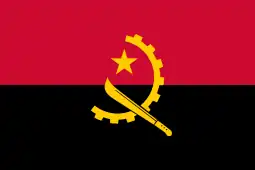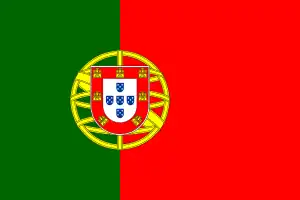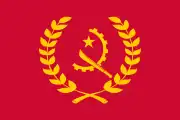 | |
| Use | National flag |
|---|---|
| Proportion | 2:3[1] |
| Adopted | 11 November 1975[2] |
| Design | A horizontal bicolour of red and black, with a yellow half gear wheel crossed by a machete and crowned with a star in the center. |
| Designed by | Henrique de Carvalho Santos António Alberto Neto |
.jpg.webp)
The national flag of Angola came into use when Angola gained independence on November 11, 1975. It is split horizontally into an upper red half and a lower black half with an emblem resting at the center. It features a yellow half gear wheel crossed by a machete and crowned with a star.
History
The flag was designed by Henrique Onambwé. The process of cutting and sewing the first version of the flag was done by Joaquina, Ruth Lara and Cici Cabral on November 11, 1975.[3]
The Angolan flag is based on the flag of the Popular Movement for the Liberation of Angola (MPLA), one of several groups which fought Portuguese colonial rule. It emerged as the ruling party of Angola following the suppression of all dissent in the Angolan Civil War.[1] The MPLA flag is similar to the flag of Angola but features a star in place of the central emblem.[1]
Description
The National Flag of the Republic of Angola has two horizontal bands of red and black with the Machete and Gear Emblem in gold in the center consisted of a five pointed-star within a half gear wheel crossed by a machete (resembling the hammer and sickle used on the Soviet flag).[2] As outlined in the Constitution of Angola, the red half of the flag signifies bloodshed – during Angola's colonial period, independence struggle, and in defense of the country. The black half symbolizes Africa. In the central emblem, the gear represents industrial workers and production, the machete represents peasantry, agricultural production and the armed struggle, and the star, shaped like the red star, symbolizes international solidarity and progress. The yellow color of the emblem symbolizes the country's wealth.[4] The Constitution of 1975 described the red stripe as symbolizing bloodshed during the colonial period, national liberation and a revolution – and reference to revolution was replaced with "defense of the country" in the constitution of 1992. In other changes of wording between the 1975 and 1992 versions, the star was changed from a symbol of "internationalism" to "international solidarity", and references to "working class" and "peasant class" were replaced with "workers" and "peasants".[5][6]
Colors
| Red | Yellow | Black | |
|---|---|---|---|
| CMYK | 20/100/90/0 | 0/15/100/0 | 10/10/10/100 |
| Pantone[7] | 186 C | 116 C | Process Black C |
| RGB | 204/9/47 | 255/203/0 | 0/0/0 |
| Hexadecimal | #C8102E | #FFCD00 | #000000 |
2003 proposal
In 2003, a new, more "optimistic" flag that dropped the Communist imagery was proposed by the Parliament's Constitutional Commission of the National Assembly (Angolan Parliament), but it was not adopted, and the proposal was suppressed by the ruling party. The sun design in the middle is meant to be reminiscent of cave paintings found in Tchitundo-Hulu cave. The flag maintained the same flag proportions of 2:3.[8]
Gallery

.svg.png.webp) Flag proposal for the Portuguese overseas province of Angola (1967) – never used.
Flag proposal for the Portuguese overseas province of Angola (1967) – never used. Flag of the former movement and now governing party MPLA
Flag of the former movement and now governing party MPLA Flag of UNITA, a former movement and now opposition party in Angola
Flag of UNITA, a former movement and now opposition party in Angola.svg.png.webp) Proposed flag of Angola (1996)
Proposed flag of Angola (1996).svg.png.webp) Proposed flag of Angola (2003)
Proposed flag of Angola (2003) Presidential standard of Angola
Presidential standard of Angola
See also
References
- 1 2 3 Flags of the world (2nd ed.). Buffalo, New York: Firefly Books. 2012 [2003]. p. 26. ISBN 978-1-77085-157-3.
- 1 2 Flags: The visual guide to more than 300 flags from around the world. New York City: Dorling Kindersley. 1998. p. 96. ISBN 0-7894-4224-8.
- ↑ Hermínio Escórcio: O MPLA tinha um Plano B, mas preferiu pôr de lado. Jornal de Angola. 11 de novembro de 2020.
- ↑ Constitution of the Republic of Angola (PDF). Luanda, Angola. 21 January 2010. Annex I. Archived from the original (PDF) on 1 June 2019. Retrieved 16 May 2020.
{{cite book}}: CS1 maint: location missing publisher (link) - ↑ Lei Constitucional da República Popular de Angola (PDF) (in Portuguese). 1975. Article 54. Archived from the original (PDF) on 2021-07-06. Retrieved 2020-05-16.
- ↑ Constitutional Law of the Republic of Angola (PDF). 1992. Article 162. Archived from the original (PDF) on 2021-07-05. Retrieved 2020-05-16.
- ↑ "Símbolos Nacionais da República de Angola: Manual de Normas Gráficas e Protocolares". www.governo.gov.ao. Archived from the original on 2019-09-01. Retrieved 2019-06-20.
- ↑ "Angola - proposals for a new flag". www.crwflags.com. Retrieved 2017-07-21.